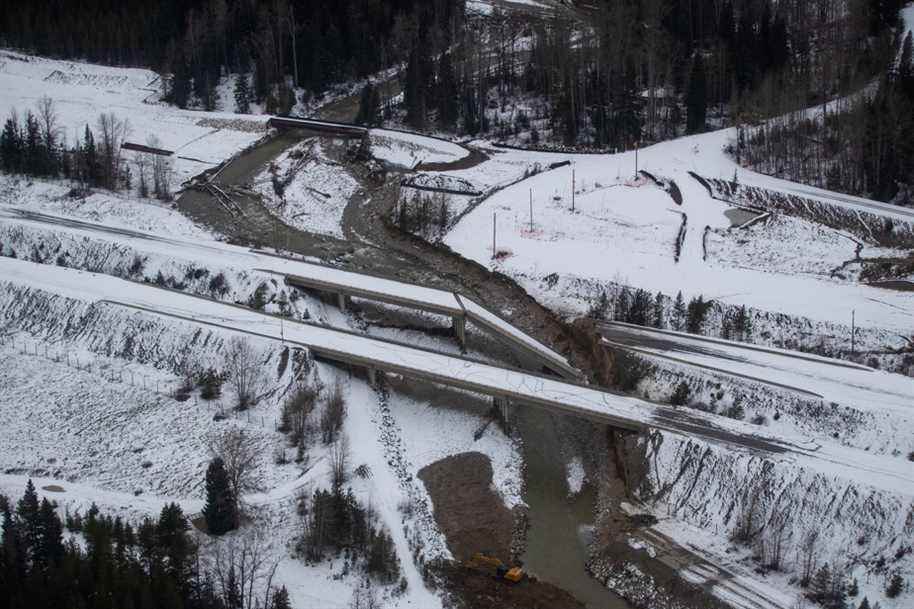Hard hit by torrential rains that caused historic flooding, part of British Columbia’s Fraser Valley will now face a snowstorm. New precipitation that could complicate the work of teams deployed in the field to urgently repair roads and infrastructure.
Snow and again rain
A heavy snowfall hit the Fraser Valley on Monday and is expected to continue on Tuesday, as 25 to 30 cm of precipitation was expected for the area of the Coquihalla Highway, between the towns of Hope and Merritt. Further south, Abbotsford, the city most affected by the disaster, will be able to breathe a little: 2 to 4 mm of rain are expected on Tuesday. The situation is likely to worsen as of Thursday, when Environment Canada predicts another atmospheric river in southern British Columbia. This weather phenomenon, well known in the West, carries large quantities of water vapor which turns into torrential rains. 40 to 60 mm of rain could fall in the Fraser Valley on Thursday, and even up to 100 mm, reports Armel Castellan, meteorologist at Environment Canada.
” We cross fingers ”

PHOTO JENNIFER GAUTHIER, REUTERS
Abbotsford seawall repairs progressed well over the weekend.
At a press conference on Monday, Abbotsford Mayor Henry Braun spoke of substantial progress in repairing the dike that is holding back the water. But he admits “crossing his fingers” for the next few days. “If we get 100mm of rain in 24 hours, it’s going to be problematic,” he agrees. If it melted quickly, snow that fell further north on Tuesday could also add significant amounts of water that would flow into the Fraser Valley. After visiting the facilities of one of the pumping stations in the city of Abbotsford, Mayor Braun admitted that the situation could have been much more critical. “I understood how very close we had come to a much worse disaster. We came very close to losing this critical infrastructure. Henry Braun extended the state of emergency for a week.
Air Canada increases its cargo capacity

PHOTO JENNIFER GAUTHIER, REUTERS
Two members of the rescue teams observe the damage on an Abbotsford railway line.
Air Canada said on Monday it had increased its cargo capacity after flooding cut key supply links to southern British Columbia. The airline says its additional capacity equates to approximately 860 adult moose by weight. The Port of Vancouver, meanwhile, is still sluggish while railways CN and CP complete repairs to rail lines damaged by floods and landslides last week. In the Fraser Valley, many roads remain completely or partially closed. But the province’s guidelines banning non-essential travel in the region are still in effect. Since Friday, gasoline has been rationed in southern British Columbia. A limit of 30 liters imposed on each visit to a gas station was announced by the provincial Minister of Public Safety, Mike Farnworth.
Too early to calculate the financial impact

PHOTO JENNIFER GAUTHIER, REUTERS
In Abbotsford, several roads are still impassable.
According to British Columbia Finance Minister Selina Robinson, it is still too early to determine the impact of the flooding on the province’s finances. She nevertheless admitted that the bill would be “very high”. Her federal counterpart, Chrystia Freeland, has indicated that Ottawa will help with the reconstruction efforts ahead. A First Nations leader also criticized the British Columbia government for failing to warn people living in at-risk areas of the dangers of torrential rains that occurred a week ago. According to Terry Teegee, the province could have acted more quickly after the dome of heat that hit the region over the summer. “This year alone, we expect everyone to be ready. First Nations communities are already mortgaged, even before a forest fire, even before a flood. ”
Thousands of dead animals

PHOTO DARRYL DYCK, ARCHIVES THE CANADIAN PRESS
Flooded farm in Abbotsford
British Columbia Agriculture Minister Lana Popham said Monday that thousands of animals had perished in the flooding and authorities were preparing on how to dispose of the carcasses. Many animals will also need to be euthanized. The water level is still too high, however, to start such an operation, said the minister. The region is one of the most important in British Columbia for dairy and poultry production. It is also home to 80% of the province’s egg production.
With The Canadian Press

